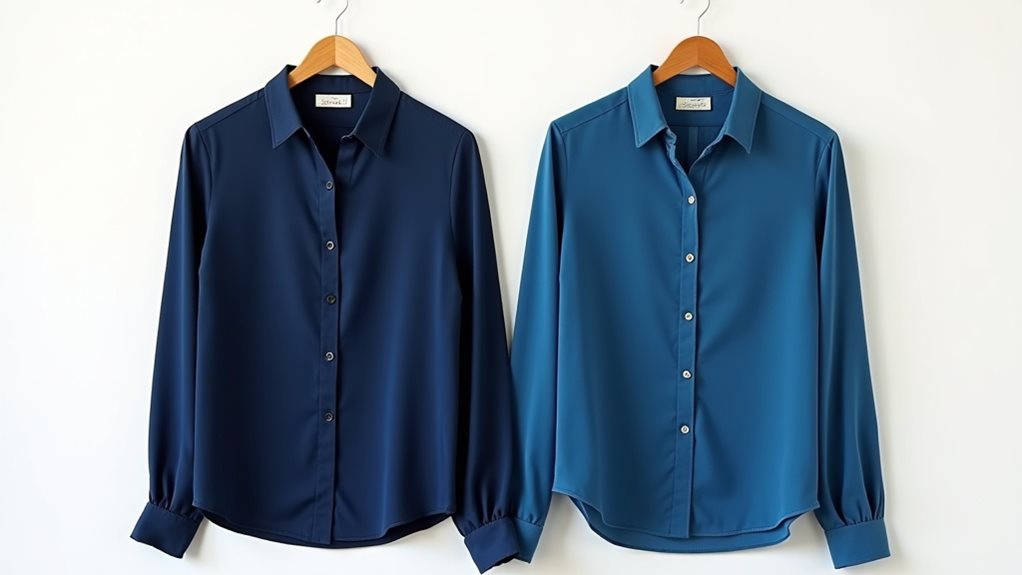Yes, dry cleaning can absolutely prevent fading because those specialized solvents work like gentle guardians for your clothes, dissolving dirt and oils without the harsh water exposure that makes dyes bleed out. I’ve watched my favorite silk blouse maintain its vibrant emerald color for years through professional cleaning, while similar pieces turned dull from regular washing. The chemically inert solvents create a protective environment that preserves your garment’s original integrity, and understanding which fabrics benefit most will transform how you care for your wardrobe.
How Dry Cleaning Solvents Protect Fabric Colors
While many people assume that frequent cleaning inevitably leads to faded clothes, dry cleaning actually works as your garment’s color guardian, using specialized solvents that treat your favorite pieces with the respect they deserve.
Here’s the beautiful thing about dry cleaning solvents – they’re organic compounds that dissolve oils and dirt without introducing water, which means you’ll never worry about color bleeding ruining your wardrobe again.
Unlike my college laundry disasters (RIP, white socks turned pink 😅), these non-reactive solutions prevent fading by avoiding chemical reactions with fabric dyes.
The gentle treatment protects your investment, allowing garments to retain original color through regular dry cleaning sessions, while crystal-clear fluids maintain vibrancy that keeps your clothes looking fresh and new.
This preservation of fabric integrity is particularly crucial for delicate fabrics like silk, wool, and cashmere, which are especially susceptible to color deterioration when exposed to traditional water-based washing methods.
The Science Behind Color Preservation in Dry Cleaning
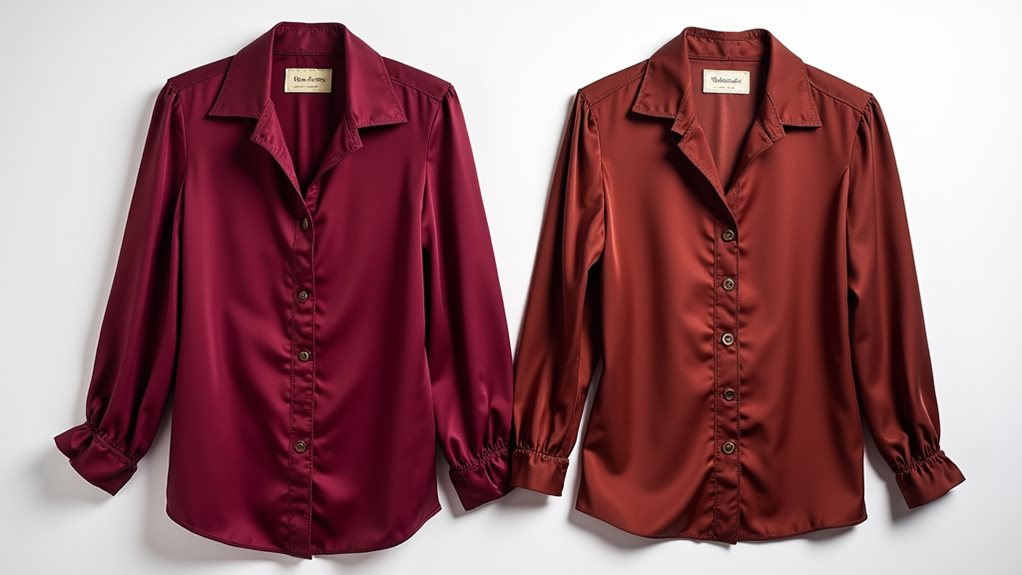
Understanding exactly how these color-protecting solvents work their magic requires looking at the molecular level, where the real science happens between your garment’s dyes and the cleaning compounds.
Unlike water-based washing that causes dye molecules to loosen and migrate, dry cleaning solvents used in professional facilities create a gentle, non-reactive environment that maintains color integrity beautifully.
Professional dry cleaning solvents create a non-reactive environment that preserves fabric dyes, unlike water-based washing that causes color migration and fading.
These specialized compounds don’t chemically bond with fabric dyes, which means your favorite navy blazer keeps its rich hue instead of turning that dreaded grayish-blue 😅.
Regular dry cleaning also prevents oxidation-related staining that permanently damages delicate fabrics over time.
The crystal-clear solvent after cleaning proves no dye extraction occurred, helping maintain the quality and prevent discoloration that ruins fabric quality permanently.
While dry cleaning excels at color preservation, the chemical solvents used in the process are primarily designed for cleaning rather than sanitizing garments.
Why Water-Based Washing Causes More Fading Than Dry Cleaning
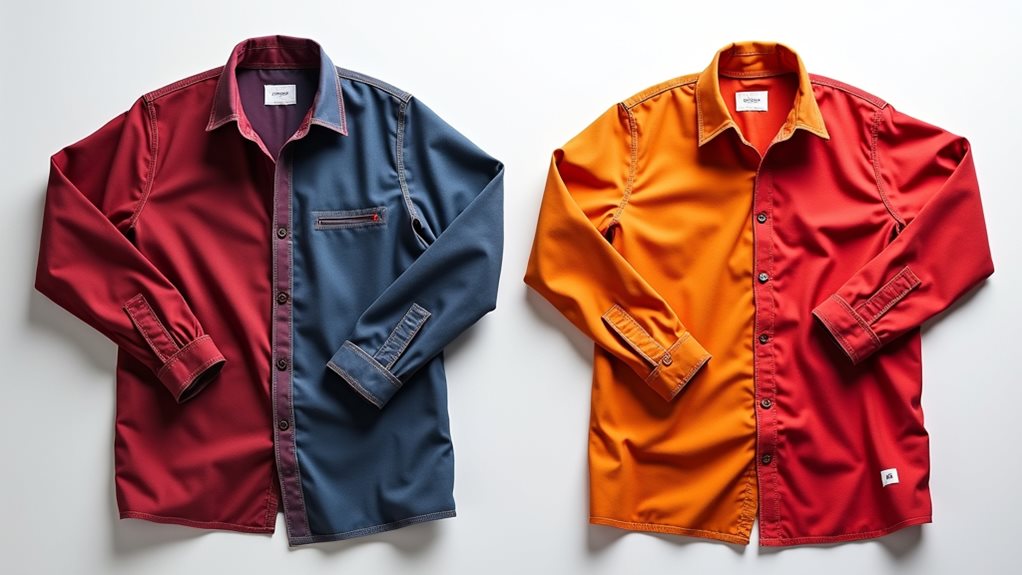
When you toss your favorite shirt into the washing machine, you’re fundamentally subjecting it to a perfect storm of color-destroying forces that dry cleaning completely sidesteps.
Water-based washing creates aggressive mechanical action that literally beats your clothes around, causing wear and tear on delicate fibers while hot water opens fabric pores, allowing dyes to bleed out like watercolors in rain.
I’ve watched my own shirts fade from vibrant blues to sad, washed-out grays after just a few cycles!
Dry cleaning’s gentle solvents preserve color integrity by avoiding this harsh treatment entirely. These non-reactive chemicals clean without the fabric swelling or dye migration that water causes, maintaining both fabric integrity and those gorgeous, saturated colors you paid good money for. The most common solvent used in professional dry cleaning is perchloroethylene, which effectively removes stains and dirt without causing the color bleeding associated with water-based methods.
Chemically Inert Solvents Vs Traditional Cleaning Methods
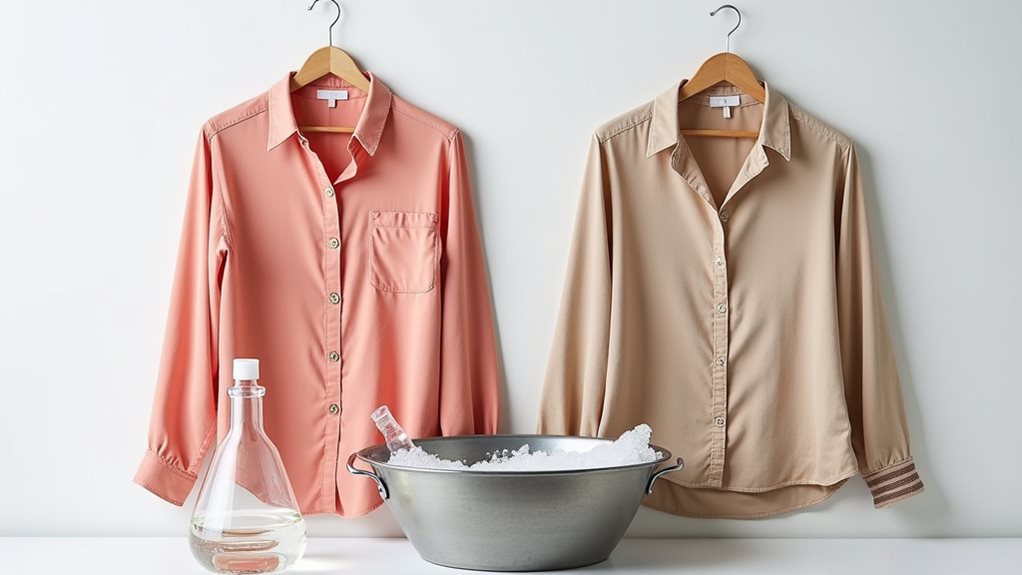
Although most people assume all dry cleaning solvents work the same magic, I discovered the hard way that traditional perchloroethylene (perc) can actually betray your favorite garments by chemically reacting with dyes, turning my once-stunning burgundy blazer into a disappointing, mottled mess after just three cleanings.
That’s when I learned about chemically inert solvents like siloxane, which don’t react with garment dyes at all, preserving vibrant colors while effectively removing stains during the cleaning process.
Unlike traditional washing methods that strip colors mercilessly, these superior fluids maintain your garments’ original hues without the dulling effects of perc.
Beyond color preservation concerns, it’s worth noting that PERC has been classified as a probable human carcinogen by health agencies, making the switch to safer alternatives even more compelling.
Investing in dry cleaners who use crystal clear, non-reactive solvents greatly improves the longevity of garments, preventing color fading while keeping your wardrobe looking fresh and vibrant for years to come.
Professional Stain Removal Without Color Damage
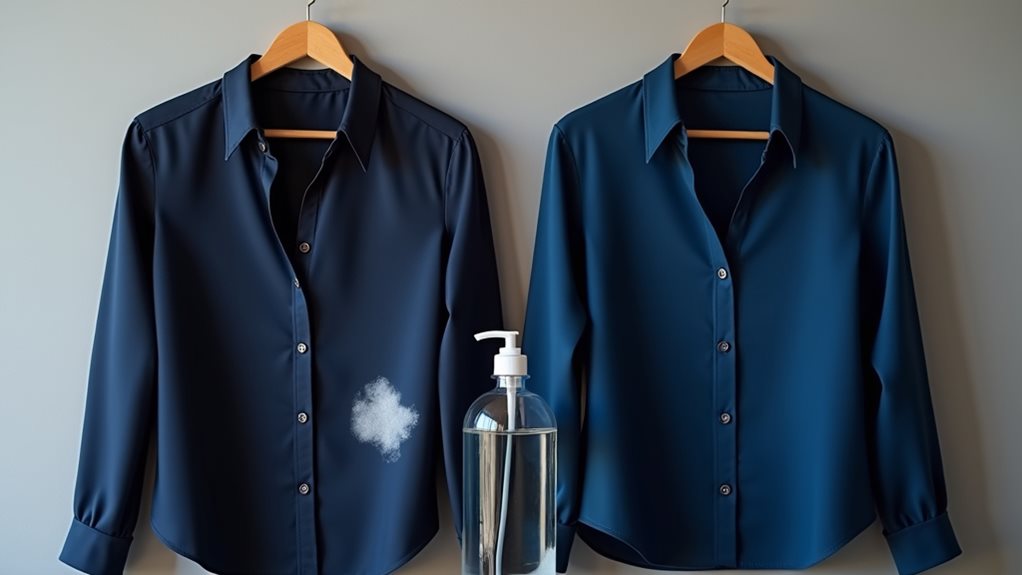
Since discovering the transformative power of chemically inert solvents, I’ve become equally fascinated by how skilled dry cleaning professionals tackle those nightmare stains that would normally spell doom for your favorite colored garments.
When you bring that wine-stained silk blouse or grease-marked wool coat to experienced dry cleaners, they use specialized techniques that target stubborn stains without compromising the fabric’s integrity.
Professional stain removal involves pre-treating each mark with specific solvents designed to break down different stain types while preserving color vibrancy.
Unlike home remedies that often cause color fading through harsh scrubbing or bleaching agents, regular dry cleaning maintains your garments’ quality and appearance.
The gentle process guarantees fabrics maintain their softness while eliminating even the most persistent stains, giving your wardrobe a longer, more vibrant life.
This specialized cleaning method is particularly crucial for delicate fabrics like silk, wool, and cashmere that can be damaged by water and traditional washing methods.
Which Fabrics Benefit Most From Dry Cleaning’s Color Protection
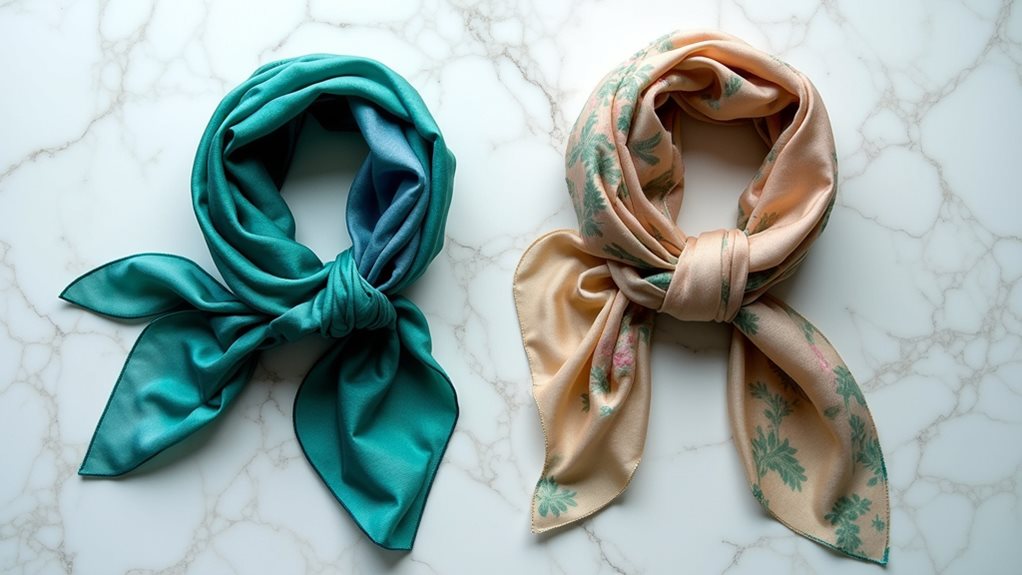
Building on that expertise in professional stain removal, I’ve learned through countless wardrobe mishaps that certain fabrics practically beg for dry cleaning’s gentle touch when it comes to color preservation.
Silk blouses, wool sweaters, and velvet dresses are absolute divas that’ll punish you with faded colors if you dare toss them in your washing machine. Dark-colored garments made from cotton and linen also benefit tremendously from professional cleaning, as it prevents that dreaded color bleeding that turns your favorite black shirt into a sad gray shadow.
Your precious silk and wool pieces are high-maintenance divas that demand professional care to keep their colors from turning tragic.
Delicate fabrics with embellishments, rayon pieces that shrink faster than my confidence at high school reunions, and leather items all maintain their vibrant hues through regular dry cleaning.
The key advantage is that dry cleaning uses chemical solvents instead of water, which helps preserve special dyes and prevents color deterioration that commonly occurs with traditional washing methods.
Trust me, your garments will thank you!
Signs Your Dry Cleaner Uses Quality Color-Safe Solvents
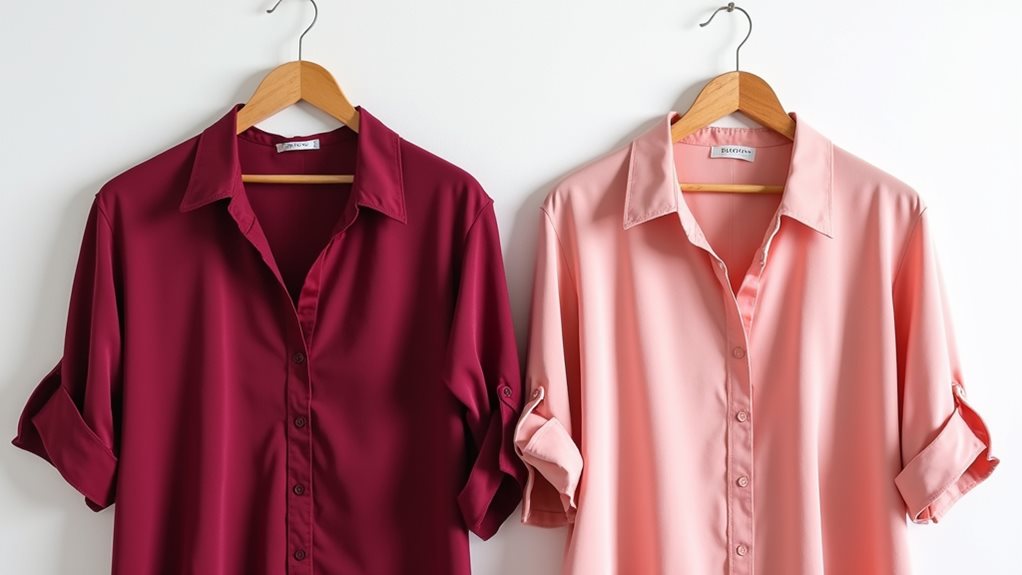
You’ll know you’ve found a keeper when your dry cleaner’s solvents look as crystal clear as that expensive bottled water you splurge on during grocery runs, because quality establishments use pristine fluids that won’t strip the life out of your favorite black dress or navy blazer.
I learned this the hard way after watching my go-to little black dress turn an unfortunate shade of charcoal gray at a sketchy place down the street, and now I always peek behind the counter to check their solvent tanks when I’m scoping out a new cleaner.
The real tell-tale sign is that their cleaning fluid stays completely transparent even after processing dark garments, which means zero dye bleeding occurred during the process – basically the dry cleaning equivalent of a clean bill of health! 😊
These chemical solvents work so effectively because they don’t cause the same dye bleeding and color loss that water-based washing methods typically create.
Crystal Clear Solvent Appearance
Crystal clarity in your dry cleaning solvent tells a story that’s worth paying attention to, much like how you’d notice the difference between muddy puddle water and pristine mountain spring water.
When you peek behind the scenes at your cleaner’s operation, crystal clear solvent appearance serves as one of the most reliable visual indicators of quality care.
High-quality solvent that maintains its transparency doesn’t extract dye molecules from your garments, helping prevent dulling and preserve those rich, vibrant colors you love.
Think of it this way: cleaning fluid clarity directly reflects your cleaner’s commitment to prevent fading and maintain original appearance.
Professional dry cleaners typically use perchloroethylene or alternative eco-friendly solvents that should maintain their clear appearance when properly maintained and filtered.
It’s honestly fascinating how something so simple can reveal so much about the care your clothes receive!
No Dye Bleeding Issues
Professional cleaners who prevent dye bleeding use color safe solvents that treat your fabrics with respect, guaranteeing your investment pieces maintain their original vibrancy.
Regular dry cleaning with these superior methods becomes your secret weapon for extending the life of those show-stopping pieces, making fading prevention feel effortless rather than stressful.
Unlike water-based washing that can cause colors to run or fade, chemical solvents used in dry cleaning effectively clean garments while preserving the fabric’s original color integrity and texture.

